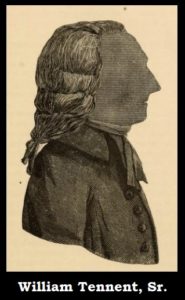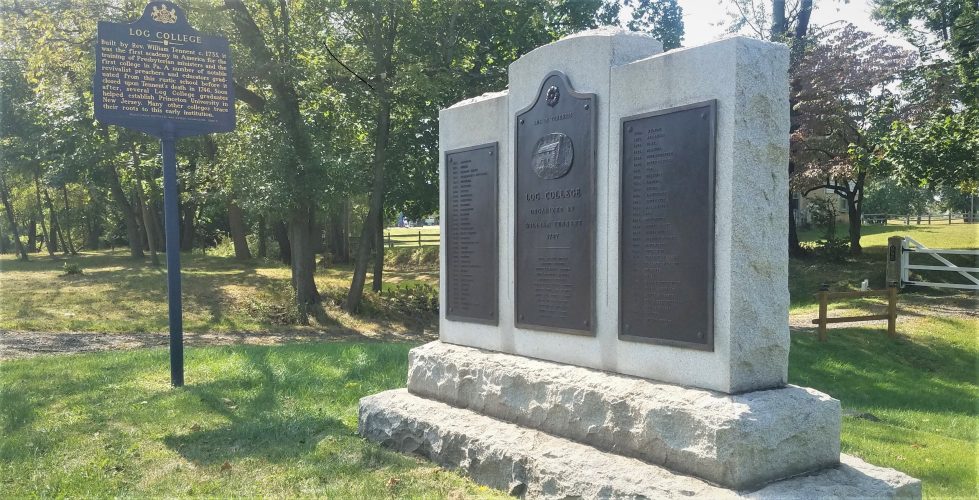 Before providing a biography of William Mackay Tennent, it is helpful to consider the frequently used name William by the Tennent family. It is all too easy to confuse one William with another. William, Sr. (1673-1745) was a Scotsman who emigrated from Ireland to the American Colonies with his wife Katherine (Kennedy) Tennent. One possibly spoiled daughter had four brothers, from eldest to youngest, Gilbert (1703-1764), William, Jr. (1705-1777), John (1707-1732), and Charles (1711-1771). Note that William, Jr., had a son who came to be designated in some sources as William, III. In the era, parents generally did not distinguish their sons as junior, the third, or so on. Possibly, in the Colonies this was because parents did not want their sons to take on royal designations given their antipathy to The Crown. In light of English history, how many colonists seeking freedom of worship would have wanted to name their child Charles II? In Alfred Nevin’s Encyclopedia of the Presbyterian Church there are entries for William, Sr., William, Jr., and William the son of junior, however he is not called William III but instead “a son of Rev. William Tennent, of Freehold, N.J.” When William Mackay Tennent is added to the list, it makes at least four Williams bearing the Tennent surname in the first three generations. All four Williams were ministers. It is likely these four are not the only Williams in the Tennent clan of the time.
Before providing a biography of William Mackay Tennent, it is helpful to consider the frequently used name William by the Tennent family. It is all too easy to confuse one William with another. William, Sr. (1673-1745) was a Scotsman who emigrated from Ireland to the American Colonies with his wife Katherine (Kennedy) Tennent. One possibly spoiled daughter had four brothers, from eldest to youngest, Gilbert (1703-1764), William, Jr. (1705-1777), John (1707-1732), and Charles (1711-1771). Note that William, Jr., had a son who came to be designated in some sources as William, III. In the era, parents generally did not distinguish their sons as junior, the third, or so on. Possibly, in the Colonies this was because parents did not want their sons to take on royal designations given their antipathy to The Crown. In light of English history, how many colonists seeking freedom of worship would have wanted to name their child Charles II? In Alfred Nevin’s Encyclopedia of the Presbyterian Church there are entries for William, Sr., William, Jr., and William the son of junior, however he is not called William III but instead “a son of Rev. William Tennent, of Freehold, N.J.” When William Mackay Tennent is added to the list, it makes at least four Williams bearing the Tennent surname in the first three generations. All four Williams were ministers. It is likely these four are not the only Williams in the Tennent clan of the time.
William Mackay (or, Mackey) was born at White Clay Creek, New Castle, Delaware, January 1, 1744, to Charles and Martha (Mackay) Tennent. In 1741, the Presbyterians had separated into the Old and New Sides with William, Sr., a leader of the New Side who exercised considerable influence for his views through educating young men in the Log College. William Mackay grew up with New Side influences directing his education at home before he entered the College of New Jersey (Princeton University). The College of New Jersey continued the New Side education provided by the Log College. After graduating with eighteen others in 1763, he studied theology for an extended period until licensed by the Presbytery of Lewes, May 1770. At the time, the Congregationalists and Presbyterians both held to the Westminster Confession of Faith, which meant Presbyterian ministers sometimes took calls to Congregational churches. This was the case for William M. Tennent. He was ordained by the Congregational Church in Greenfield (currently, Greenfield Hill), Connecticut, June 17, 1772. That fall, he married Susanna Rodgers, who was the daughter of Rev. John Rodgers, D. D., minister of the Brick Church in New York.
When the Revolution came in 1776, after serving for a short time as a chaplain William Mackay remained with the Greenfield church and held the congregation together in a time when some ministers left their flocks and moved to locations they believed were safe havens. During the war inflation ate into everyone’s funds including those held by the Tennents. When William, Jr., died in 1777, it left his pulpit in Freehold, New Jersey, vacant. William Mackay was offered the call. It appears he was about to accept the call, but the Greenfield congregation wanted him to stay so some members subscribed to provide goods in addition to his monetary salary and forty loads of wood per year. One congregant contributed “Lisbon salt” which was considered the best salt for flavor enhancement and preservation of meats and fish.
Daniel Sherwood, 1 1/2 bushels of wheat; Cornelius Hull, 4 bushels of Indian corn; Eliphalet Hull, 4 bushels of corn; John Alvord, 1 pair of women’s shoes [Alvord must have been a cobbler]; John Hull, 20 weight of butter; Jedediah Hull, 2 bushels of corn and one of wheat; Albert Sherwood, 2 bushels of wheat; Joseph Straton, 6 bushels of wheat; John Straton, 1 bushel of wheat; Stephen Straton, 6 lbs. of flax [used to make linen]; Seth Sherwood, 2 bushels of wheat; James Redfield, 15 lbs. of pork; Nehemiah Banks, 40 lbs. of pork; Oliver Middlebrooks, 1 bushel of corn; Ebenezer Banks, 1/2 bushel of Lisbon salt; Joseph Banks, 1 barrel of cider; Eliphalet Banks, 1 barrel of cider.
The staples reflect the bread, corn, and pork diet of the day, but fish are curiously missing given the proximity of Greenfield to Long Island Sound. The congregation’s kindness and concern convinced William to stay.
In 1781, William Mackay accepted a call to the Presbyterian Church at Abington, Pennsylvania, where he continued until his death December 2, 1810. During his tenure the church built a new building in 1793 on the opposite side of what is currently Old York Road. Ashbel Green, who would soon become president of Tennent’s beloved College of New Jersey delivered the funeral sermon that was published as Life, and Death of the Righteous: An Address at the Funeral of the Rev. William M. Tennent, D. D., 1810. William was buried in the Abingdon Church cemetery where Susannah joined him November 28, 1819. Their infant covenant daughter Elizabeth Bayard (Jan 22, 1793 to May 12, 1793) awaits the resurrection with her parents.
In memory of the
Rev. William M. Tennent, D. D.
Who was born January 1, A. D. 1744
Licensed to preach the Gospel in May, 1770, ordained
to the work of the Gospel Ministry at Greenfield in
Connecticut in June 1772. Removed to this church in
connection with the Presbyterian church of Norrington
and Providence in December 1781, and having with zeal
and fidelity discharged every pastoral duty, and shown an
instructive example of Christian temper and private worth.
He closed his life with a most edifying exhibition of
Christian humility, fortitude, and faith, through the
whole of a tedious illness, of which he died December 2d,
1810, In the 67th year of his age.
Archibald Alexander said in his book, The Log College, that William and Susannah had an inviting home.
He was a man of great sweetness of temper and politeness of manners, and was distinguished for his hospitality. His house was seldom without the company of friends and acquaintances; and all who had the privilege of visiting at his pleasant retreat, were delighted with their cordial reception and kind entertainment. (p. 163)
Even though William M. Tennent may have been lost among the Tennents named William, he was an important minister in his day. His Congregational Church beginning did not inhibit him from dedicated ministry as a Presbyterian when he moved to Abingdon. He was moderator of the General Assembly of the Presbyterian Church in the United States of America in 1797. The minutes for that year include a detailed listing of the presbyteries and their ministers’ names; an overture asking whether a man could be admitted to communing membership who “had married his former wife’s half-brother’s daughter” (found to be improper but did not exclude him from communing membership); issues within the Presbytery of Abingdon (eastern Tennessee, roughly); and a proposal from John Blair Smith regarding the office of ruling elder (postponed to the next Assembly). At the time the denomination had 165 churches (40 vacant), 152 ministers, and 14 licentiates. When he delivered his retiring moderator’s sermon the next year his Scripture text was the last clause of Matthew 28:20, “And lo, I am with you always, even unto the end of the world.” In 1800, he toured portions of Delaware and Maryland for the General Assembly to raise funds for the denomination and received nearly 1500.00. He also was a board member for the College of New Jersey, 1785-1808, and worked hard raising funds for his alma mater. McLachlan provides the following comment Tennent wrote in a letter to his wife dated July 15, 1805: “One thing I promise you—I will never go on a begging tour again.” He never did. Anyone who has sought funds can identify with his frustration and decision to stop soliciting funds. William received the degree of Doctor of Divinity from Yale College in 1773. Two of his publications are available at Log College Press–a sermon titled “On the Love of Money,” from 1 Timothy 6:10, 1791, and a letter dated January 11, 1806. The Presbyterian Historical Society in Philadelphia has some manuscript sermons and letters, but other than the items mentioned it appears there are not any extant publications by William M. Tennent (unless another William has been credited with them).
Barry Waugh
Notes—The portrait is Rev. William Tennent, Sr. (1673-1746), as from the 1851 edition of Archibald Alexander’s Biographical Sketches of the Founder and Principal Alumni of the Log College. Together with an account of the revivals of religion under their ministryAs was the case with James Latta, no portrait of William M. Tennent was located. Thank you to Andrew Myers for the photograph of the Log College memorial and historical marker in Neshaminy, Pennsylvania; the two side panels list the institutions of higher learning that came from the Log College. Andrew also provided the information about the W. M. Tennent items on the Log College Press site (added 7/26/2021). Milton J. Coalter, Jr., Gilbert Tennent, Son of Thunder: A Case Study of Continental Pietism’s Impact on the First Great Awakening in the Middle Colonies, A Publication of the Presbyterian Historical Society, Contributions to the Study of Religion, Number 18, New York: Greenwood Press, 1986, provides some family history. Henry B. Smith, Transactions of the One Hundred & Fiftieth Anniversary of Greenfield, CT., Congregational Church, held May 18th, 1876, Southport: Chronicle Print, 1876, has biographical information and the information about the congregation subscribing to boost Tennent’s income via staples. James McLachlan, Princetonians: 1748-1768, Princeton: University Press, 1976, is from primary sources and the best of the sources. Alfred Nevin, Encyclopedia of the Presbyterian Church, 1884, has but a brief paragraph. Sprague, vol. III, Annals of the American Pulpit, has an entry for him. The Abingdon years are noted in Nicholas Baggs, History of Abington Presbyterian Church, Abington, PA., 1914. Information about “Lisbon salt” and fish preservation can be found at George Washington’s Mount Vernon.
“The Presbytery of Abingdon was constituted in the year 1786; extends in length from the New River on the north-east to the frontiers on Tennessee River on the south-west, at present about two hundred miles; and from the Blue or Eastern Ridge of the Appalachian mountains to the Cumberland mountains, about one hundred and forty miles in breadth. The congregations within the bounds of this Presbytery are as follow, beginning at the north-east.” (Minutes of the General Assembly, 1789-1820, p. 130).





